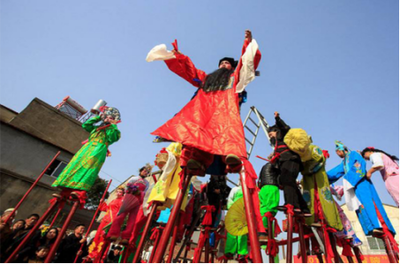Yangko, a rural Chinese folk dance with a history dating back thousands of years, originates from farming life in ancient times. The dance relates to sacrifices to the farmland god when people prayed for a good harvest. As time passed, the original dance evolved, taking in various artistic forms and skills, including opera, acrobatics and martial arts, and eventually developed into the type of Yangko that is seen today.
秧歌是一种中国乡村民间舞蹈,有几千年的历史,它起源于古代农耕文明时期。该舞蹈与祭祀农田之神“土地爷”有关,在那时人们祈祷好的收成。随着时间的推移,最初的舞蹈不断发展,呈现出多种艺术形式和技巧,包括了戏曲、杂技和武术,最终发展成为今天的秧歌。

Featured among the inaugural items of national intangible cultural heritage in 2006, Yangko is mainly popular in northern China . People often perform the dance during festivals, especially for Chinese New Year and the Lantern Festival in the first lunar month. Performances or competitions are organized in towns and villages to express people's joy and their hope for a better life.
秧歌在2006年被列入国家级非物质文化遗产,它主要流行于中国北方。人们经常在节日里表演扭秧歌,特别是在中国农历正月的春节和元宵节。乡镇组织表演或比赛,表达人们的喜悦以及对更好生活的希望。
Yangko employs drumming, a Suona horn, dancing and singing. Content is based on folk stories and legends. Costumes are richly-colored and opera-styled, enabling characters to be easily identified. During a performance, the actors will dance and sing, following lively rhythms. Highly-skilled and interesting acts such as stilt walking and carrying a wedding sedan chair are also included. Yangko enjoys high popularity among the general public due to its humorous yet joyful form.
打鼓、唢呐、跳舞和唱歌是秧歌的主要表演形式。表演内容基于民间故事和传说。服装色彩丰富,多以戏剧服饰为主,表演人物易于辨认。在一场表演中,演员们跟着生动的节奏载歌载舞,技术高超且有意思的踩高跷和抬花轿也包括在内。秧歌以其幽默而欢快的形式,深受公众喜爱。
